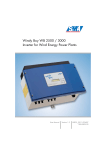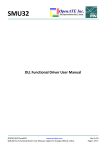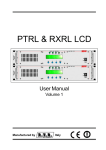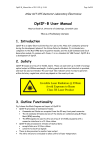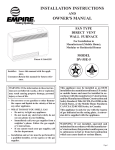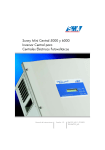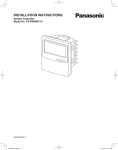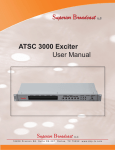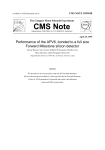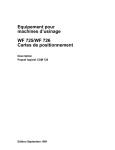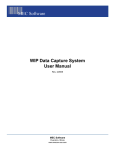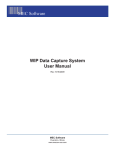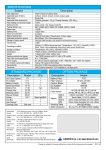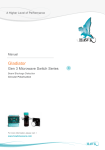Download APV6 User Manual - CMS Tracker Control
Transcript
APV6 User Manual Author: Email: M.French [email protected] Phone: Fax: +44 1235 446484 +44 1235 445753 Post: Rutherford Appleton Laboratory Chilton Didcot Oxon OX11 0QX United Kingdom Version: 1.0 Notes: This is a working document that will be updated frequently. Please pass comments and requests for the inclusion of more information to the above author. apv6_manual.doc Version: Draft 1 16/10/96 1 . Document History Date Revision Number Description 16/10/96 1.0 First draft version apv6_manual.doc Version: Draft 2 16/10/96 2 . Contents 1. Document History 2. Contents 3. Related Documents 4. Introduction to the APV6 and Analogue Read-out in the CMS Tracker 5. Physical Size and Pad Layout 6. Logic Levels 7. Control Interface 8. Biasing the APV6 9. Running the APV6 10. Data Output Format 11. Using the Internal Test Pulse System 12. Other Features apv6_manual.doc Version: Draft 3 16/10/96 3 . Related Documents Name Author Notes Specifications for the Control and Read0out Electronics for the CMS Inner Tracker A. Marchioro CMS Working document APV6 Requirements M.French Part of the RAL QA project specification Balaton Paper M.French Presented at 2nd LHC workshop on electronics apv6_manual.doc Version: Draft 4 16/10/96 4 . Introduction Copper differential low voltage drive APV6 APV6 APV6 APV6 APV6 APV6 APV6 APV6 APV6 APV6 APV6 APV6 Link driver chip Quad laser unit Mux driver -A -A -A -A APV6 APV6 APV6 APV6 -A -A -A -A APV6 APV6 PLL timing trim chip I2C Link Optical ribbons to FED module LVDS CK and T1 Figure 1: Analogue Read-out in the CMS silicon tracker The architecture of the CMS tracker readout system is based on analogue processing of data in t h e detector prior to transmission in analogue form via an optical interface to the counting room. Here i t will be digitised and processed to remove offsets and reorder channels before passing up the DAQ tree. Some of the system is still being specified but the silicon front end modules will be as shown in Figure 1. Here eight APV6 chips will be used to process 1024 detector channels. As with the APV5 version the chip contains a preamplifier and shaper stage for each channel. Each channel then has a 160 location memory into which samples are written at the LHC 40MHz machine frequency. Thus the memory always contains a record of the most recent beam crossings the chip has sensed. A data access mechanism allows the marking and queuing of requested locations for output. Embedded logic ensures that the samples awaiting readout are not overwritten with new data. Requested samples from the memory are processed with a deconvolution filter (APSP), a switched capacitor network, that deconvolves the shaping function of the preamplifier and shaper stages to recover the initial pulse shape. After the APSP the data is held in a further memory buffer prior to switching through an output analogue multiplexer. This additional buffer is required so that as one event is multiplexed out another may be prepared for consecutive transmission. The APV6 also contains features required for a final CMS design including programmable on chip analogue bias networks, a remotely controllable internal test pulse generation system and a slow control communication interface. Figure 1 also shows two other chips on the Front-end hybrid, a clock and control receiver and a multiplexer driver chip. The clock and control receiver is required to locally generate the clock and trigger signals in the appropriate form and timing for the APV6. I t will also interface the hybrid I2C slow control data bus to the next level up in the control system. The multiplexer driver chip is required to mix, by interleaving, the output data from pairs of APV6 chips onto four analogue outputs that transmit to a separate optical driver board. In this way a apv6_manual.doc Version: Draft 5 16/10/96 multiplexing level of 256 to 1 is achieved at the hybrid output. Both of these chips are in design a t RAL and CERN for fabrication in radiation soft form. apv6_manual.doc Version: Draft 6 16/10/96 5 . Physical Size and Pad Layout The overall dimensions of the APV6 chip are shown in Figure 2 below. Four groups of 32 input pads 1 INP<127> VSS APV6 GND VDD 1 13 INP<0> 37 Bias monitor pads Back-end pads Figure 2: APV6 overall dimensions (dimensions in microns) The design will be fabricated using the standard Harris AVLSI-RA process flow. The wafers will be of 4 inch type and 19mils (approx. 500um) thick. A table showing the precise co-ordinates of t h e centre of each pad may be obtained from RAL, please request it if required. 5.1 Analogue inputs The 128 analogue inputs are grouped into four sections of 32. Each section is separated by larger power supply pads. These power connections supply the preamplifier stages (where most of the APV6 power is used) and must be bonded to supplies close to the chip. Use the shortest bond length and multiple bonds if possible (to minimise inductance). Note: The reason for powering the chip in this way is so that the power losses in the APV6 routing, and the area wasted in large power buses is minimised. Each group of inputs is arranged in two staggered rows, each rows pads are spaced at 86um. The inner row is offset 43um clockwise (viewed from the centre of the APV6). Thus the effective bond pitch within each group is 43 um. Each pad is 100um long and 60um wide (the passivation opening is about 3um smaller than this). The pads are labelled from <0> to <127>. The Inp<0> is on the lower left of the first group and Inp<127> is at the top right of the top section. The analogue inputs all have small protection diodes to VSS and VDD. These are not intended to meet standard levels of protection but should prevent damage during assembly if reasonable antistatic measures are taken. For them to work effectively the VDD GND and VSS pads should be bonded first and grounded to the assembly machine. 5.2 Bias monitor pads These are intended for test purposes only. They enable a direct measurement of the bias voltages and currents set in the bias generator. The first test systems should permit bonding to these points to allow apv6_manual.doc Version: Draft 7 16/10/96 the user to monitor or override the levels generated internally. There are thirteen test points and they are tabulated below: Pad Number Name Type Measure to 1 V_BG current VSS 2 IPRE current VSS 3 VPRE voltage GND 4 VCAS(P) voltage GND 5 ISFB(P) current VSS 6 ISHA current VSS 7 VSHA voltage GND 8 VCAS(S) voltage GND 9 ISFB(S) current VSS 10 IPSP current VSS 11 VADJ voltage GND 12 CLVL current VSS 13 VDEL voltage GND Table 1: Bias monitor points Note that when measuring a current by connecting the meter to VSS t h e current flows in the meter and is starved from the internal mirroring in the APV6. This means that t h e measurement will prevent the chip from working, during operation these points must normally be left open circuit. The VCAS and ISFB have two entries even though each has only one control word in the bias generator. This is because they are required both in the preamplifier and the shaper. To prevent possible undesired feedback the reference for the two stages are independently mirrored out of the bias generator and consequently appear at two pads. The pads V_BG and VDEL both do not relate directly to bias channels. V_BG can be used to measure the reference current for the bias generator, this prevents the bias generator mirrors from working so must not be made at the same time as any other measurement, the nominal value for this current is 128uA. VDEL is connected to the calibration delay line. When the calibration feature is enabled (calibration inhibit OFF) this voltage should “hunt” (small steps up and down in voltage around t h e optimum bias point for the delay elements). Monitoring this voltage and observing the “hunt” effect will indicate that the delay line has successfully locked onto the clock. See section “APV6 Using t h e internal calibration system” for more details. External capacitance connected to the VDEL pad will slow down the “hunt” effect and so may upset the measurement. 5.3 Backend Pads All of the IO, address pads and remaining power supply pads are located down the back edge of t h e chip. There are 37 in total and a full list describing their function is shown in Table 2. The pads are approx. 100um by 60um and are on a 150um pitch. There is one pad “gap” next to the current output and the fast differential input pairs (clock and control) have an additional 50um spacing from their neighbours. Normally all of the pads of type “TEST” may be left unconnected. They are designed for use in test and early evaluation of the chip. The pads of type “BIAS” may be left unconnected (with t h e exception of BRES which should be connected to the -2V supply) if the internal bias reference is used. For details of how to use an external reference or the reference propagation system see section XXX. The clock and trigger inputs are of low voltage differential type, the remaining inputs require switching between +2 and -2V. The pads PORT, SCLK and SDIN have a hysteresis characteristic because the expected edges on these signals may be very slow. apv6_manual.doc Version: Draft 8 16/10/96 Pad Position Name Type Function 1 AVSS POWER Analogue -2V Supply 2 AVDD POWER Analogue +2V Supply 3 CAL0 TEST Charge injection test point 4 CAL1 TEST Charge injection test point 5 CAL2 TEST Charge injection test point 6 CAL3 TEST Charge injection test point 7 BINP BIAS Bias reference override input 8 BRES BIAS Internal bias reference -2V supply 9 BOT1 BIAS Reference current output 10 BOT2 BIAS Reference current output 11 BOT3 BIAS Reference current output 12 BOT4 BIAS Reference current output 13 BOT5 BIAS Reference current output 14 BOT6 BIAS Reference current output 15 PROBE TEST Pad connected to -2V supply for probe edge sensor 16 AOUT OUTPUT 17 PORT INPUT Power On Reset Pad 18 ADD0 INPUT APV Address bit 19 ADD1 INPUT APV Address bit 20 ADD2 INPUT APV Address bit 21 ADD3 INPUT APV Address bit Current mode analogue output 200um GAP 22 OUTE OUTPUT Digital output, switches low when analogue data is output 23 SDOT OUTPUT I2C Data Output 24 WPTK TEST Memory write pointer test point 25 TPTK TEST Memory trigger pointer test point 26 DEL1 TEST Calibration unit test point 1 27 DEL2 TEST Calibration unit test point 2 28 DVDD POWER 29 AGND GROUND 30 HERA INPUT Digital +2V pad Analogue Ground Connection Tie to +2V for HERA mode or -2V for normal (LHC) mode 100um Gap 31 CLKN INPUT 40MHz clock negative input (low voltage type) 32 CLKP INPUT 40Mhz clock positive input (low voltage type) 33 TRGN INPUT 34 TRGP INPUT 100um Gap Trigger negative input (low voltage type) Trigger positive input (low voltage type) 100um Gap 35 SDIN INPUT I2C data input 36 SCLK INPUT I2C clock input 37 DVSS SUPPLY Digital -2V supply Table 2: Backend pad listing, Pads (100um by 50um) spaced at 50um unless specified otherwise apv6_manual.doc Version: Draft 9 16/10/96 6 . Logic Levels 6.1 Digital 6. 1. 1 INPUT 6 . 1 . 2 INPUT (Low Voltage Type) 6 . 1 . 3 OUTPUT 6.2 Analogue 6 . 2 . 1 TEST inputs 6 . 2 . 2 OUTPUT apv6_manual.doc Version: Draft 10 16/10/96 7 . Control Interface The configuration, bias setting and error states of the APV6 are handled with a two wire serial interface. It is designed to conform to the Phillips I2C standard so that it may be controlled by a standard off the shelf components (e.g. PCD8584 parallel bus interface chip). 7.1 The I2C standard This protocol is specified completely in the Philips data books so need not be repeated here. The APV chips may only act as slave devices. They are addressed using the standard 7-bit mode where t h e most significant bits are “001” and the remaining 4 bits are defined by bonding out address pads on t h e APV6. The 4 address pads (ADD0, ADD1, ADD2, ADD3) each possess internal pull-up resistors (of approx. 80Kohm) to VDD. Selective bonding of these pads to VSS therefore allows any address pattern to be set. The APV will only execute the requested command if the 3 most significant bits are “001” and t h e 4 remaining bits match the bonded address setting. The APV address “1111” is reserved for “global” addressing. When the “1111” chip address is used in an i2c transfer all connected APVs will respond. Consequently a maximum of 15 APV6 chips may share the same controller and maintain unique addresses. 7.2 Communicating with the APV6 The APV6 interface logic has a command register that must be programmed before data may be transferred. This register defines which variable or register is to be accessed and specifies t h e direction of data transfer. The least most significant bit is high for read and low for write operations. A complete table of the command codes is shown in Table 3. 7 . 2 . 1 Writing to the APV6 Data is written to the APV6 with one I2C transfer with two 8 bit data packets. The first packet defines the APV address, t h e second specifies a command register (in both cases the read bit must be low) and the third specifies the new value for the register. Function or Variable Command Register Code An example of an IPRE write operation is shown in Figure 3 Error register Mode register 00 00 00 1X 7 . 2 . 2 Reading from the APV6 Latency register 00 00 01 0X To read data from the APV6 the command register must first be written. Reading requires two separate I2C transfers. 00 00 00 01 IPRE 01 00 00 0X ISHA 01 00 00 1X IPSP 01 00 01 0X ISFB 01 00 01 1X VPRE 01 00 10 0X The first packet defines the APV address (read bit low), the second specifies the command register (read bit high). Any further data packets are ignored. VSHA 01 00 10 1X VADJ 01 00 11 0X VCAS 01 00 11 1X CLVL 01 01 00 0X Transfer 2 Read the data back CSKW 01 01 00 1X Once the command register has been programmed the APV6 may be read by a standard I2C read sequence, the APV will respond with a single 8-bit packet corresponding to the addressed data. CDRV 01 01 01 0X Transfer 1 apv6_manual.doc Write the command register Version: Draft 11 Table 3: Command Register Codes 16/10/96 Subsequent reads of the same register is possible without re-programming the command register. If the APV is addressed as “global” for reading all APVs will respond. The serial data output is of open drain type so if more than one APV6 responds the logical AND of all addressed APV’s will be sensed. An example of an IPRE read operation is shown in Figure 4. 7.3 Command register codes The command register codes are 8-bit with the last bit determining the direction of transfer. The command codes are listed in Table 3 with MSB first, X=1 for read operations, X=0 for write operations. 7.4 Error register definition For short periods the APV6 may be triggered at a rate faster than it can output data. When this happens a queue develops in the APV6. The length of this queue is limited by the number of spare locations in the memory and an address fifo that stores the addresses of columns awaiting read-out. As the queue grows, depending on the latency programmed, eventually the fifo becomes full or all t h e available memory locations become allocated. Either case leads to pipeline failure. The circuit must then be reset with a RESET101 sequence to clear the fault. Fifo error The fifo error is simply found by keeping a record of the number of addresses stored (limit=19). In deconvolution mode three addresses must be stored for each trigger, so in this case the limit is six triggers. For peak processing where only one address is stored the limit is nineteen. Latency error The memory function is continuously monitored by a latency test (the separation between the write and trigger pointers should always be equal to t h e programmed latency). This is checked every time the memory is overwritten (at least once every 160 pipeline clock cycles). Error Value = 0 Value = 1 <1> fifo error OK <0> latency error OK Table 4: Error register definition The function of the error register is to report these two classes of failure. The error bits are active low so that its possible to read a group of APVs in one go with the “global” read operation, the “wire-and” of the open drain outputs pulls the output low if any of the APVs have the appropriate error. Note: When a new latency value is written a Latency Error will inevitably be produced. T h e pipeline must be restarted to initialise the pointers with the new separation. This must be done with a RESET101 sequence which will also clear the Error. apv6_manual.doc Version: Draft 12 16/10/96 7.5 Mode register definition Three functions are controlled by the APVs “Mode” register. They default to the underlined conditions tabled below (at power-up) and may be read and overwritten (not altered by RESET101). Calibration inhibit OFF/O N Mode Value = 0 Value = 1 <2> calibration inhibit OFF calibration inhibit ON <1> “deconvolution” “peak” processing processing <0> analogue bias analogue bias The calibration logic contains a self regulating OFF ON “clocked” delay line may cause noise in t h e system. For this reason it should be inhibitted Table 5: Mode register definition when not in use. At power on it defaults to t h e inhibitted condition. The use of this function is fully described in section XXX. APSP operation Deconvolution/ P e a k Deconvolution mode enables the three sample weighted deconvolution algorithm that confines t h e shaped signal to one beam crossing (suited to LHC operation). When operating in “Peak” mode only one sample is stored and is output directly. Analogue O F F/ O N The analogue bias control allows the bias conditions of the chip to be disabled whilst the required values are programmed into the bias generator. Enabling analogue bias then lets the programmed values to take effect. This is particularly useful at power-up where the default is “OFF”, thus t h e power consumption of the system may be ramped up in a controlled fashion. 7.6 Latency register definition This register contains a binary number that defines the separation between the “Write” and “Trigger” pointers in the analogue memory controller. The register defaults at power-up to a value of bit<7:0>=10000100. This corresponds to a count of 132 clock cycles. This value may be reprogrammed to any value up to 156. Note: Programming larger values of latency reduces the cells available for queuing output d a t a , and will impact on the efficiency of the APV6 at high trigger rates. To program a new latency the binary number equivalent to the required number of pipeline cycles must be written by an I2C write operation. Then the circuit must be reset with a RESET101 trigger sequence. In “Peak” mode this number represents the number of exact clock periods between a signal being sensed at an analogue input and outputting the sample on the peak of the CR-RC shape. In deconvolution mode the first sample must be three clock cycles before that point. Thus in deconvolution mode to get the same effective latency the number programmed must be three counts larger. 7.7 Bias generator settings The bias of the analogue stages in the APV6 is controlled by an internal “Bias Generator” part. There are three classes of bias; current, voltage and charge. The bias block produces only current in each case. Currents are output directly, voltage bias levels are then generated by internal termination resistors chosen to give appropriate ranges of adjustment, and charges are generated by switching the current into load resistors and then converting the voltage step generated to charge with a series capacitance. The bias part requires a reference current from which all of its levels are scaled. This is generated internally with a resistor network but may be overridden by an external source. apv6_manual.doc Version: Draft 13 16/10/96 Bias Name Class Range Resolution Value (n = 0 to 255) Description IPRE I 0 to 1020uA 4uA n 5 4uA Preamplifier bias current ISHA I 0 to 255uA 1uA n 5 1uA Shaper bias current IPSP I 0 to 127.5uA 0.5uA n 5 0.5uA ISFB I 0 to 255uA 1uA n 5 1uA APSP bias current Source follower bias current VPRE V VDD to VSS 18mV VDD - (n 5 18mV) Preamp feedback bias voltage VSHA V VDD to VSS 18mV VDD - (n 5 18mV) Shaper feedback bias voltage VADJ V GND to VSS 9mV GND - (n 5 9mV) Output level adjustment VCAS V GND to -1.02V 4mV GND - (n 5 4mV) Cascode voltage bias level CLVL Q 0 to 15.3fC 0.06fC n 5 0.06fC Reference for internal charge injection system Table 6: Bias control range and resolution (128uA bias) The nominal value for the reference current should be 128uA. The resolution and ranges for each bias setting are derived from that reference, so will scale if this is overridden. The voltage and charge accuracy also depend on the polysilicon resistance used in the internal conversion resistance. This may vary by as much as 20%. The charge accuracy also depends on the value of the series injection capacitor. These injection capacitors are close to the scribe of the chip, for yield reasons they are constructed using overlapping metal1 and metal2. This gives a further variation in the charge injected. For the above reasons t h e charge injection scale must be measured or calculated at test, recorded and then used to scale absolute measurements. 7.8 Example I2C Write transfers 7 . 8 . 1 Set the preamp bias to 500uA Hex Supposing the chip address is bonded to t h e pattern 0101. The address byte is 00101010 2A(hex). This is 001 (APV), 0101 (chip address) and 0 for I2C write. Binary Address Byte 2A 00101010 Command Byte 40 01000000 Data Byte 7D 01111101 Table 7 Example preamp bias write The command register byte must be 01000000 40(hex) see Table 3 (write IPRE entry). The IPRE current is governed by the equation n54uA (see Table 6), the closest value of 488uA therefore corresponds to a “n” of 7D(hex). 7 . 8 . 2 Set the preamp bias voltage to 0.5V Supposing the chip address is bonded to t h e pattern 0101. The address byte is 00101010 2A(hex). This is 001 (APV), 0101 (chip address) and 0 for I2C write. Hex Binary Address Byte 2A 00101010 Command Byte 48 01001000 Data Byte 53 01010011 Table 8 Example preamp bias voltage write The command register byte must be 01001000 48(hex) see Table 3 (write VPRE entry). The VPRE voltage is governed by the equation VDD – (n 5 18mV) see Table 6, assuming VDD of 2V, 0.506V corresponds to a “n” of 53(hex). apv6_manual.doc Version: Draft 14 16/10/96 Structure of an APV I2C Write command sequence: CHIP ADDR 001=APV 3 SDA SCK 2 1 ACK (From APV) SCK(From APV) R/W ACK (From APV) 0 7 APV Write Call 6 5 4 3 2 1 0 7 6 5 APV Control register 4 3 2 1 0 New APV data Example: Write Preamp bias of 488uA to APV chip "0101" SDA SCK APV Write Call APV Control register New APV data Figure 3: Example I2C write Structure of an APV I2C Read command sequence: 3 SDA SCK 2 1 0 APV Write Call CHIP ADDR 001=APV 7 6 5 4 3 2 1 0 3 APV Control register SCK(From Controller) SCK(From APV) 2 1 0 R/W CHIP ADDR 001=APV ACK (From APV) R/W ACK (From APV) 7 6 5 4 3 2 1 APV Read Call Data From APV APV Read Call Data From APV 0 Example: Read Preamp bias (Value set to 122 decimal i.e. 488uA) SDA SCK APV Write Call APV Control register Figure 4: Example I2C read apv6_manual.doc Version: Draft 15 16/10/96 7 . 8 . 3 Set mode register Hex Supposing the chip address is bonded to t h e pattern 0101, and we want to set calibration logic to off, enable “peak” processing and enable t h e analohue bias to all APV chips. Binary Address Byte 3E 00111110 Command Byte 02 00000010 Data Byte 07 00000111 Table 9 Example mode register write The address byte is 00111110 1E(hex). This is 001 (APV), 1111 (global address) and 0 for I2C write. The command register byte must be 00000010 02(hex) see Table 3 (write Mode register). The three bits used in the register must all be set to “1” see Table 5. Programme 00000111 i.e. 07(hex), the leading zeros are ignored. 7.9 Timing The I2C standard is specified at 400 kbit/s. This is so that bus capacitances of 200 to 400pF may be used with reasonable values of pull-up resistance. The APVs internal logic is capable of running a t speeds much higher than this, even up to 40Mhz. The limiting factor is the external load capacitance and resistance. The SCK and SDA inputs both have a hysteresis chractersitic of 0.5V(min) and will switch within the range of +/-1V. The output resistance of the SDA output pad is approximately 500 ohms (when pulling low). To ensure that this is capable of pulling the SDA line below -1V, pull up resistors of 2K2 or higher must be used. If the pull-up is of current source type this should be no greater than 1.5mA. 7.10 Pad Specification Since the APV may only ever act as a slave device, it need never drive the clock line. For this reason the clock SCK connects to one input pad “SCLK”. The data line is bidirectional, for easy test this has been split into two pads that may be shorted external to the chip. The data input pad to the APV is called “SDIN”. The data output pad is called “SDOT”. The Full list of pads and their description may be found in the section “Physical Layout of t h e APV6”. apv6_manual.doc Version: Draft 16 16/10/96 8 . Biasing the APV6 This section describes how to bias the APV6. Bias adjustment is necessary for several reasons. I t allows the user to optimise performance against power consumption, accomodate manufacture tollerences and compensate for changes in operating point that arise from irradiation of the circuit. At each stage in the signal processing chain each adjustable variable is listed and the expected effects described. Finally a procedure for biasing up a chip for the first time is outlined. 8.1 Stage 1: Preamplifier The preamplifier circuit is shown schematically in Figure 5. The amplifier is charge sensitive, its gain is determined by the feedback capacitor Cf. VPRE Rf IPRE/10 Cf Input Output VCAS IPRE ISFB Figure 5: Preamplifier schematic It should respond to a charge signal with a proportionate step at its output and decay with a long (>500ns) time constant. The charge gain (the step size divided by charge applied), is determined by the feedback capacitor, 0.25pF. Name Principle Effect Nominal Value Reasonable Range IPRE Preamp Noise 500uA 200uA to 1mA 20uA to 100uA ISFB Output impedance 50uA VCAS Accomodates Vt change 0V 0V to -1V VPRE Vary Preamp fall time -0.4V +1V to -1V Table 10: Preamp Bias Summary 8. 1. 1 I P R E This sets the current in the preamplifier stages of each channel. The primary effect of altering this bias is on the electronic noise and power consumption. At very low settings an additional effect will be that the preamps output rise time will increase, this then increases the rise time of the shaped signal increasing the peaking time. Assuming a chip bias of 128µA the IPRE value set follows the relation IPRE=(n 5 4µA). 8. 1. 2 ISFB This controls the amount of current in the source follower output device. This variable also controls a similar stage in the shaper stage. It is not expected that any adjustment from the 50uA nominal setting will be required. If this is set too low the output impedance of the shaper will drop, this will apv6_manual.doc Version: Draft 17 16/10/96 lead to loss of signal height and distortion of the pulse shape. Assuming a chip bias of 128uA t h e ISFB value set follows the relation ISFB=(n 5 1µA). 8. 1. 3 VCAS The preamplifiers output source follower is Ntype, the operating point of the output node is determined by the pmos input device. Nominally the output voltage is expected to be around -1.2v, I t is important the cascode device stays in saturation, this means that its drain must be above its gate voltage. To ensure that the cascode device can be maintained in saturation, adjustment of VCAS may be required. The effect of a to high VCAS bias will be a drop in open-loop gain, this will cause poor pulse shape and noise performance. Before irradiation the expected optimal setting for this bias is 0v dropping to -0.5v after irradiation. The VCAS value set follows the relation VCAS=GND – (n 5 4mV). 8. 1. 4 VPRE The function of the preamp is to provide a voltage step to the shaper, to prevent pile-up effects a long tail is required. The effect of adjusting VPRE on the preamp and shaper output is shown in figure X below. Figure 6: The effect of changing VPRE The higher voltage set the smaller the feedback resistance (and therefore the time constant) becomes. Assuming a chip bias of 128uA the VPRE value set follows the relation VPRE= VDD – (n 5 18mV). 8.2 Stage 2: Shaper The shaper amplifier circuit uses the same architecture as the preamplifier. apv6_manual.doc Version: Draft 18 16/10/96 9 . Running the APV6 Once set-up the APV6 requires only one control line, TRG, to run. This control line is normally held a t zero. It is possible to send three commands on it, a TRIGGER (a single “1”), a CALIBRATE REQUEST (a double “11”) and a RESET101 (two “1” separated by a gap). Consequently consecutive triggers or triggers next to calibration requests may get confused with the reset signal, for this reason the user must inhibit these occurances. RESET101 signal is used to clear the pipeline and initialise t h e memories pointer system. After power-up and appropriate programming of the various control registers described in the previous section a RESET101 is required after which the TRIGGER or calibration requests can be sent. The trigger latency is the time (in the number of pipeline clock cycles) between a detector signal being applied to an APV6 input and the cycle that the TRIGGER signal must be applied to the chip to output that signal at its peak. This number corresponds to the separation of pointers in the memeory that specify the read and write locations. 9.1 Sending a RESET101 A RESET101 sequence clears any pipeline pointers and relaunches them with the programmed latency separation. The 101 sequence, is really sensed by the chip as 1X1, so the sequence 111 will have t h e same effect. In fact any train of consecutive “1”s of at least 3 will cause a RESET101. In the case of extended reset sequences the reset is not released until the end of the sequence. Pipeline Pointer Separation Trigger signal 6 int(Write Pointer) int(Read Pointer) Initialisation Phase Triggers valid from this point Figure 7: Reset and initialisation process An example in shown in Figure 7, here a RESET101 is applied and internal signals are then generated to start the write and trigger pointers. The separation of these signals corresponds to the value programmed in the “Latency” register. No triggers should be sent whilst this initialisation process is in progress as errors may result. For this reason no triggers should be sent within 6 clock cycles of prgrammed latency. 9.2 Sending a TRIGGER This signal requests data for an event of interest from the APV6. It is simply a single “1” on the TRG line. An example of a TRIGGER is shown in Figure 8 below. After recieving the signal the APV6 marks the samples corresponding to the “Signal Time” and queues them for output from the APV6. As soon as output processing time is available in the APV6, it starts to process the event by retreiving the data from memory and applying deconvolution processing (if enabled) after which the data is multiplexed out of the APV in the format specified in section XXX. apv6_manual.doc Version: Draft 19 16/10/96 2 Peak sample Detector signal Shaper Output Trigger Signal Trigger Latency Signal Time (S) Trigger Time (T) Figure 8: Definition of trigger latency There are 2 clock cycles delay in processing the TRIGGER request prior to it being applied to t h e pipeline. When the pipeline is clocked at 40Mhz the shaper takes two cycles to reach its peak value see Figure 8. For this reason the peak of the pulse shape is the sample output. Figure 9: Peak vs Deconvolution pulse shape When deconvolution processing is enabled the case is slightly different, see Figure 9. Here three 25ns samples on the 50ns pulse shape are added to form a pulse shape that is confined to one beam crossing. At the peak of t h e new shape the first two samples occur before, and one on, the rising edge of the 50ns pulse. In deconvolution mode, the first sample is 3 cycles earlier than the peak of t h e 50ns shape, for this reason the effective latency in “deconvolution” mode is always three cycles shorter than the programmed value. 9.3 Sending a Calibrate Request This is described completely in section XXX. The request is simply a double “1”. When this is sensed by the APV6 an internal step on a calibration line is generated. This causes a pulse that may then be read by a sebsequent trigger a “Latency” period later. The channels “hit” with the calibrate pulse, its magnitude, polarity and timing are all programmable, see seection XXX. Calibrate Request Trigger Trigger Latency Trigger signal int(Cal Line) int(Pulse Shape) Calibrate Step Resulting Pulse Figure 10: Calibration Request example apv6_manual.doc Version: Draft 20 16/10/96 1 0 . Data Output Format 10.1 General The output from the APV6 is in current form and in the range of 0 to +600uA. The output of the chip is approximately zero when there is nothing to transfer, but, when an event has been triggered data is output in the form shown in Figure 11. A data set is made up of three parts, a digital header, address and an analogue data set. 600 Output Current (uA) 500 400 300 4 bit header 128 analogue levels 200 100 0uA Address 7.0 microseconds Time Figure 11: APV6 output data format 10.2 Header Four logic samples, should all be high, i.e. 15uA. If an error is sensed by the APV6 internal watchdog logic the second sample is switched low. This is so that erroneous data packets in the DAQ can be identified and reported to the control system 10.3 Address An 8-bit number which defines the column address that was used to store the samples in the analogue memory, this can be used to monitor the synchronicity of many chips and as a tool to aid t h e identification and removal of data from “bad” memory locations. 10.4 Analogue data 128 samples of analogue data, where a MIP equivalent signal should be represented by a current of 50uA. The baseline offset may be adjusted (VADJ) to give optimal dynamic range in the signal polarity in which a chip is working. apv6_manual.doc Version: Draft 21 16/10/96 1 1 . Using the Internal Test Pulse System 11.1 General A schematic illustrating the operation of the internal test pulse system is shown in Figure 12 below. The circuit contains two chains of delay elements that are automatically regulated to give a delay of one eighth of a pipeline clock period. When a cal request has been received by the chip a clock pulse is launched down the top delay line. This pulse clocks the toggle flip-flop when it passes the delay chosen with the Delay Set register. The resulting change of state causes analogue amplifiers to switch between two states applying a voltage step to the preamp inputs in 8 groups of 16. Groups can be masked off by setting bits in the Calibrate Mask Register to allow only one or many to be active a t any time. Amplitude defined by bias channel Demux Toggle FF Delay Set 8 Multiplexer Cal Request 8 Calibrate Mask Register D Sequence Logic Preamp Inputs Delay bias regulator AAAAAAAAAAAAAAAAAAAAAAAAAAAAAAAAAAAAAAA AAAAAAAAAAAAAAAAAAAAAAAAAAAAAAAAAAAAAAA AAAAAAAAAAAAAAAAAAAAAAAAAAAAAAAAAAAAAAA AAAAAAAAAAAAAAAAAAAAAAAAAAAAAAAAAAAAAAA AAAAAAAAAAAAAAAAAAAAAAAAAAAAAAAAAAAAAAA AAAAAAAAAAAAAAAAAAAAAAAAAAAAAAAAAAAAAAA AAAAAAAAAAAAAAAAAAAAAAAAAAAAAAAAAAAAAAA AAAAAAAAAAAAAAAAAAAAAAAAAAAAAAAAAAAAAAA Cal Request (on trigger input) Toggle FF output Shaper response Figure 12: Schematic showing the APV6 internal test pulse system 11.2 Measuring the pulse shape apv6_manual.doc Version: Draft 22 16/10/96 1 2 . Other Features 12.1 HERA-B mode 12.2 The APV6 bias reference scheme 12.3 The APV6 Bias monitor pads apv6_manual.doc Version: Draft 23 16/10/96
























